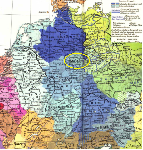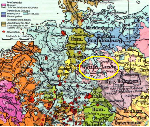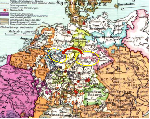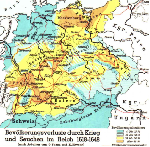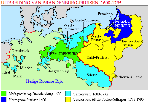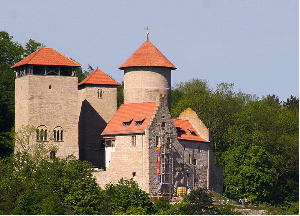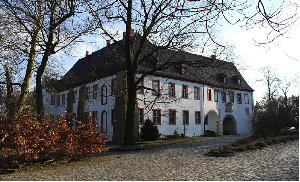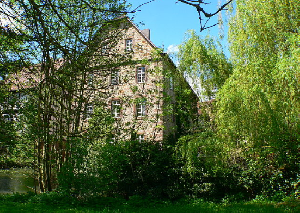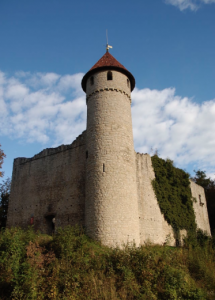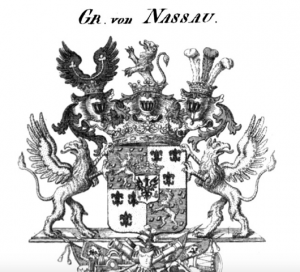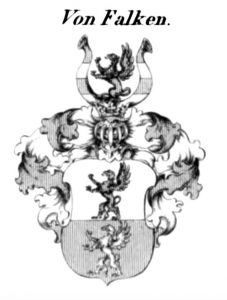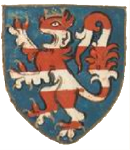 In 1336 the Knights of Treffurt are stripped of their power and ousted by Heinrich II von Hessen and House of Wettin and Archdiocese of Mainz (Gerlach I von Nassau). Shortly thereafter in 1359 (During the reign of House of Wettin, Frederick III “the Strict” Landgrave of Thuringia 1332-1381) Ritter Heyso von Falken and his brother Heinrich von Falken own a substantial part of the North-West area of Hainichs (“Burg Haineck, in Nazza). The Grafen von Falken originate from Hessen and maintain close ties with the Landgraves of Hessen due to the fact that they are blood related (Heinrich II “Der Eiserne”, 1299 – 1376 June 3rd, is the father of Heyso and Heinrich). The heroic Heyso von Falken dies in a war battle and his wife Liese becomes a widow. Heyso’s possessions go to Heinrich and Hermann von Falken (Sons of Heinrich von Falken). In his lifetime “Ritter” Heyso (and Heinrich & Konrad von Falken) founded the Falken Ritterbund (29 Sept 1385)
In 1336 the Knights of Treffurt are stripped of their power and ousted by Heinrich II von Hessen and House of Wettin and Archdiocese of Mainz (Gerlach I von Nassau). Shortly thereafter in 1359 (During the reign of House of Wettin, Frederick III “the Strict” Landgrave of Thuringia 1332-1381) Ritter Heyso von Falken and his brother Heinrich von Falken own a substantial part of the North-West area of Hainichs (“Burg Haineck, in Nazza). The Grafen von Falken originate from Hessen and maintain close ties with the Landgraves of Hessen due to the fact that they are blood related (Heinrich II “Der Eiserne”, 1299 – 1376 June 3rd, is the father of Heyso and Heinrich). The heroic Heyso von Falken dies in a war battle and his wife Liese becomes a widow. Heyso’s possessions go to Heinrich and Hermann von Falken (Sons of Heinrich von Falken). In his lifetime “Ritter” Heyso (and Heinrich & Konrad von Falken) founded the Falken Ritterbund (29 Sept 1385)
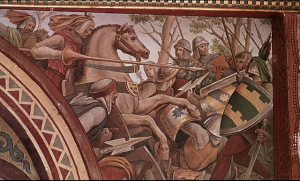
In 1423 house Wettin becomes Duke of also Saxony and also they become Elector / Kurfurst. Albrecht ( January 27, 1443 – September 12th 1500), nicknamed the Stout-Hearted, was the first Duke of Saxony from 1485 to 1500. He was the younger son of Elector Frederick the meek and progenitor of the Albertine line of the Wettin dynasty subsequent line of Electors and Kings of Saxony. House Wettin gained Meissen in 1089, Thuringia in 1263 and Saxony in 1423.
As a result and also due to the peace treaty of 1413 between Hessen and Thuringia (House of Wettin under the reign of Frederick IV “the peaceful”) the von Falken (Liborius and Mathis) were also based in Kliczschen, Triestewitz and Droferen in 1424, to protect the border of Saxony and Meissen and to take the lead in the Hussite Wars (“belehnt durch Herzog Friedrich von Sachsen”). In 1474 they were also based in Fermerswalde. Between 1424 and 1555 the von Falken family (e.g. Mathias, Konrad, Clemens, Heinrich, Johann, Christoffel) owns in its role of Graf and “kurfurstliche beamte” substantial rights of among others Triestewitz, Arzberg, Chemnitz, Nichtewitz, Bleddin, Luderitz, Rothen, Rohrda, Diensdorf, Obermollrich, Falkenstein, Hohenrode, Rittersitz Satzker (Potsdam) and Rittersitz Luempzow (Stettin). They also owned a villa in Hubenbach. In the 15th century the relation between the von Falken and von Reck was already established. This can be seen in documents of the Landgraves of Hessen. In 1420 Landgrave Ludwig I. von Hessen pawns Schloss Ziegenberg (Ziegenhagen) including villages and courts to Hans Reck. Also, Johann Reck is documented as mediator in Erfurt (Hessen) in a call for help by Mainz.
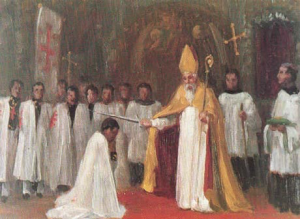 The direct connection between Falken and von Reck (Gert XIII von Reck; very loyal to the Catholic church and the Bishop of Münster) was established through the order of the Holy Sepulchre.
The direct connection between Falken and von Reck (Gert XIII von Reck; very loyal to the Catholic church and the Bishop of Münster) was established through the order of the Holy Sepulchre.
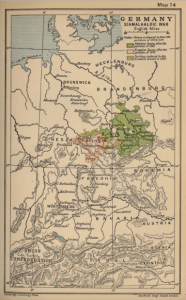 The possessions of the House of Wettin were divided after the death of Frederick II of Saxony ( Frederick the meek ) among his sons Albert and Ernst ( Distribution of Leipzig, August 26, 1485 ). This caused the Albertine and Ernestine line of the House of Wettin. Later the Albertine line provided the Kings of Saxony and Poland. Frederick of Saxony (1473-1510) was the third son of Albert of Saxony and Sidonia of Bohemia. In 1498 he became the 36th Grand Master of the Teutonic Order. Johann von der Recke of Sümmern gen. (1459-1511) was also associated with the Teutonic Order during that period (1485-1510 , commander or reval ). During the Schmalkaldic War in 1547, the Duke of Saxony (Maurice of Saxony) of the Albertine line sided with the Roman Catholic Emperor against Elector/Kurfurst John Frederick. As a reward the majority of the electorate and the electoral rights were donated to the Albertine branch by the Emperor. The Albertine Duchy was thus raised to rank electorate, while the remaining part of the old Electorate was demoted to Duchy.
The possessions of the House of Wettin were divided after the death of Frederick II of Saxony ( Frederick the meek ) among his sons Albert and Ernst ( Distribution of Leipzig, August 26, 1485 ). This caused the Albertine and Ernestine line of the House of Wettin. Later the Albertine line provided the Kings of Saxony and Poland. Frederick of Saxony (1473-1510) was the third son of Albert of Saxony and Sidonia of Bohemia. In 1498 he became the 36th Grand Master of the Teutonic Order. Johann von der Recke of Sümmern gen. (1459-1511) was also associated with the Teutonic Order during that period (1485-1510 , commander or reval ). During the Schmalkaldic War in 1547, the Duke of Saxony (Maurice of Saxony) of the Albertine line sided with the Roman Catholic Emperor against Elector/Kurfurst John Frederick. As a reward the majority of the electorate and the electoral rights were donated to the Albertine branch by the Emperor. The Albertine Duchy was thus raised to rank electorate, while the remaining part of the old Electorate was demoted to Duchy.
 In 1555, the Peace of Augsburg was signed. This treaty was based on the principle cuius regio, illius et religio. This principle states that the “Reichs Furst” determines the religion in his area . People were given the opportunity to move to an area where their religion ( Roman Catholic, Lutheran or Reformed ) could be excerised. In 1556 the Roman Catholic von Falken move more eastward in Saxony (today this line can be found in Poland under the name Falken-Plachecki) and westward to Westphalen and County Mark (ancestral seat family Reck / von der Recke). Together with their confidant, the family von Carlowitz, they were in direct contact with Charles V and Ferdinand I alongside their advisory role to the Kurfürsten of Saxony (they were “Vetter” = Cousins from von Falken). At the hight of the conflict between the Lutheran and Catholic Nobility, the Falken stayed loyal to the HRE (which did not apply to the Kurfürsten of Saxony). As a result the Falken were asked to move to the West of Germany to protect Fbd. Münster together with Raesfeld (1557: Bernard Raesfeld Fürstbischof Münster) and Reck.
In 1555, the Peace of Augsburg was signed. This treaty was based on the principle cuius regio, illius et religio. This principle states that the “Reichs Furst” determines the religion in his area . People were given the opportunity to move to an area where their religion ( Roman Catholic, Lutheran or Reformed ) could be excerised. In 1556 the Roman Catholic von Falken move more eastward in Saxony (today this line can be found in Poland under the name Falken-Plachecki) and westward to Westphalen and County Mark (ancestral seat family Reck / von der Recke). Together with their confidant, the family von Carlowitz, they were in direct contact with Charles V and Ferdinand I alongside their advisory role to the Kurfürsten of Saxony (they were “Vetter” = Cousins from von Falken). At the hight of the conflict between the Lutheran and Catholic Nobility, the Falken stayed loyal to the HRE (which did not apply to the Kurfürsten of Saxony). As a result the Falken were asked to move to the West of Germany to protect Fbd. Münster together with Raesfeld (1557: Bernard Raesfeld Fürstbischof Münster) and Reck.
In Fbd. Münster bloodlines von Falken and von Reck go together and the name Falken-Reck / Falkenreck arises: Monarchisch verfügten Namensvereinigung by Emperor Charles V. The merging of two Nobility names had to be approved by the Monarch in the 16th century in the Holy Roman Empire.
The reason behind the movement of the von Falken from Schloss Triestewitz (and also Pommern: Johann Falcken Kanzler resides in Westphalen) and the other castles had to do with a range of events resulting in the loss of power of the Catholic Nobility in the Roman Catholic empire lead by Karel V:
| 1542-1544 | von Falken participated in the emperor’s army in the war against the forces of the Sultan Suleiman the Magnificent of the Ottoman Empire (1542), Duke William of Jülich-Cleves-Berg (1543), and King Francis I of France (1544) |
| 1546-1547: | Schmalkaldic War (Battle of Muhlberg). Christoffel Falken participated in the battle. |
| 1547: | Muhlberg Treaty (Battle of Muhlberg close to Schloss Triestewitz) after Charles V defeated the Protestants/Lutherans together with Maurice of Saxony (Wettin House) who decided to support Charles V in order to gain the territory of his brother (Ernestine Line) |
| 1548: | Von Falken decide to issue a request to extend the loan of Schloss Triestewitz and other castles because of the victory of the Catholics (Charles V)*. Johann Fal(c)ken was appointed Kanzler of Pommern and visited Charles V several times in Brussels. |
| 1552: | Passau Treaty. Many Protestant Princes were unhappy with the religious terms of the Augsburg Interim imposed after this victory. In January 1552, led by Maurice of Saxony (who played a double manipulative game, first he sided with the Catholics in order to get the land and title of his nephew Johann Frederik of Saxony and after he sided with the protestant movement to gain more land and power), many formed an alliance with Henry II of France at the Treaty of Chambord. In return for French funding and assistance, Henry was promised lands in western Germany. In the ensuing Princes’ War, Charles was driven out of Germany into Italy by the Protestant alliance, while Henry captured the fortresses of Metz, Verdunand Toul. In August 1552, weary from three decades of religious civil war, Charles (convinced by his brother Ferdinand I in order to get support from the Protestants to fight the Turks) guaranteed Lutheran religious freedoms in the Peace of Passau. The implementation of the Augsburg Interim was cancelled. The Protestant Princes taken prisoner during the Schmalkaldic War, John Frederick of Saxony and Philip of Hesse, were released.[1] A precursor to the Peace of Augsburg of September 1555, the Peace of Passau effectively surrendered Charles V’s lifelong quest for European religious unity.[2] |
| 1556: | Charles V no longer emperor |
| 1556: | Von Falken (Loyal to the Roman Catholic Empire for already 300 years) no longer wanted to stay in Protestant/Lutheran Thuringia and Saxony (in the hands of the traitor Maurice of Saxony) and they move to Catholic Earldom (County) Mark (Hamm) after they have been asked by the HRE to protect Fbd. Münster. The Falken von Saxony sell their properties to the “Kurfürsten von Sachsen” before they move away from Saxony and Pommern; where in 1548 Johann Falcken was appointed Kanzler of Pommern and had close relationship with Charles V. Johann Falcken visited Karel V several times in Brussels. |
| 1557: | On behalf of the Holy Roman Empire von Falken also establish themselves in Gütersloh at the border with Gft. Ravensberg at the time Bernhard von Raesfeld becomes the Regent of Münster (Fürstbischof of Münster). The tensions in Fbd. Münster required full attention which resulted in a collaboration between the Catholic von Raesfeld, von Reck (Münster Line “zu Heessen and Steinfurt”) and Falken (-Reck). The link between von Raesfeld and Falken is made also via the Noble family von Boyneburg: – Johann Reinhard Falken Lord of Treffurt (1530-1583), father of Anna Christina Falken, was married to Genoveva Elisabeth von Boyneburg – Goswin von Raesfeld, Hofmeister zu Ahaus, (1494-1579) was married to Irmgard von Boyneburg. From a military strategy point of view it is easy to establish why Falken (-Reck) were positioned in Gütersloh. Fbd. Münster was protected from the West by the Raesfeld territory and from the South & North by the von Reck territory. However from the East there was limited protection. Both Raesfeld and Falken gained considerable pieces of land in the Gütersloh area. 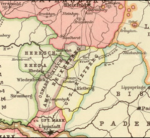  |
| 1558: | Charles V is deceased |
| 1561: | The majority of Von der Reck choose to convert to Lutheranism in order to maintain their political power and to safeguard their properties and business interests in rapidly changing times. County Mark becomes Protestant/Lutheran and Falken permanently reside in Gütersloh in the Diocese Osnabruck (Catholic). |
| 1565: | Gütersloh is the center of a religious dispute between Diocese Osnabruck (Catholic) and Protestant/Lutheran Rheda. The result is that Gütersloh is split up between both parties. The actual effect of the split up is that Gütersloh remains predominantly Catholic. The von Falken still remain loyal to the Roman Catholic Empire in reformed (protestant) Germany, after selling their possessions in Saxony (which they sold to the “Kurfursten von Sachsen”) and Pommern due to not siding with the new Protestant power. The von der Recke however had decided at the end of the 16th century to formally change sides and become Protestant. However after 1648 (the end of the thirty years war) most of them embrace the counter reformation and become catholic again, which is rewarded by the appointment of Dietrich Adolf von der Recke as bishop of Paderborn. The main reason for most of the powerful nobility to convert from Lutheran back to Catholicism was very simple. Being a Catholic noble family meant you could get your son to become a bishop, which was a well paid job. |
| +/-1573: | Hof Falkenreck was established in the vicinity of the Raesfeld Hof in Gütersloh. The relationship between v. Falken and v. Raesfeld continues into the 17th century. One of the sons of Christoffel (or Johann Falken-Reck, brother of Christoffel), Neveling Falkenreck (+/-1605 – ?) is documented as ad-interim manager at the Raesfeld Hof in Gütersloh which they co-owned with von Raesfeld. Neveling eventually returns to Hof Falkenreck and one of his sons, Gerd Falkenreck zu Spexard, runs the Spexard land (14km2) at the end of the 17th century**. |
* Lehnbrief Christoffel Falken zu Tristwitz
** Von Raesfeld and von Reck are also connected through marriage of which the proof can be found in the bedroom of Schloss Lembeck. Here the Alliance Coat of Arms Raesfeld-Reck can be seen.
Movements of the Falken family
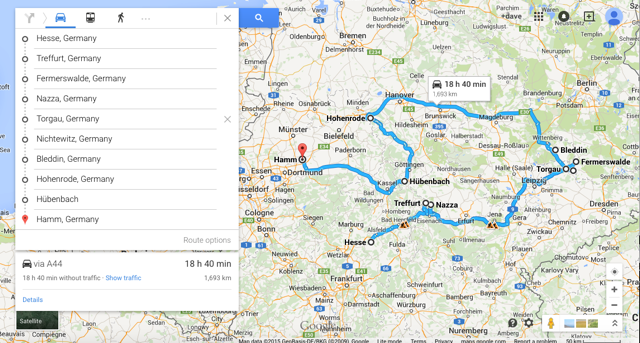
Possessions von Falken between 1359 and 1600
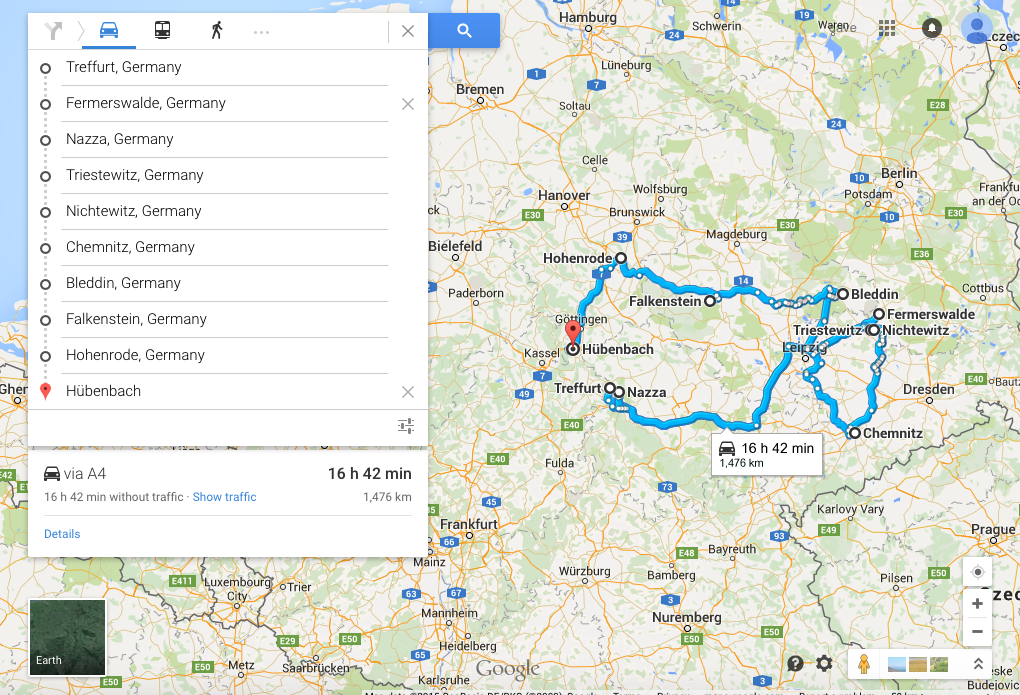
Bloodline with Oranje-Nassau
On September 3, 1582, Anna Christine von Falken, Erbin von Nassenerfurt, marries Philipp Wilhelm von Cornberg, the son of Wilhelm IV von Hessen-Kassel.
The Falken bloodline also continues in the Nassau line via Anna Christine von Falken. The most striking example of this involves the Teutonic facial features.
Even Queen Victoria of England made a comment about the features of Prince Alexander (son of King of Oranje-Nassau of Holland) in a letter to her uncle King Leopold from Belgium, after Prince Alexander had visited her to propose to her.
See below picture and the striking resemblance between Maurits Falkenreck and Prince Alexander (1851-1884):




